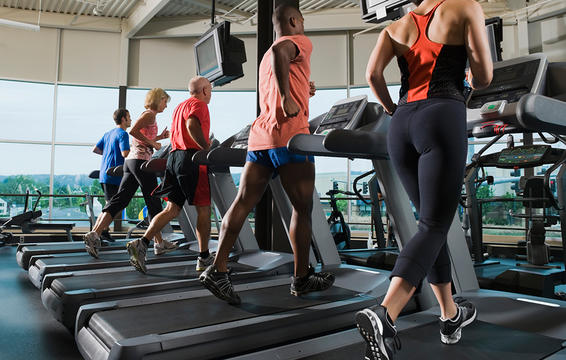Your Step-by-Step Guide To Finally Becoming A Runner
Here’s the thing about running: If you want to become a runner, the only thing you really have to do is, well, run. One step, two steps, three steps, voilà: You’re a runner!
Easier said than done, right? "Sometimes the hardest part of a run is the first step,” says Corinne Fitzgerald, a coach at New York City’s Mile High Run Club. Especially in the winter when it’s cold, or when you want to finish Stranger Things on Netflix, or when you have a fresh blowout. You can always find an excuse to skip a workout. So “lace your shoes up quick and don't give yourself too much time to overthink—less time to talk yourself out of it! No one ever regretted going for a run!"
But if you want to make running a consistent workout or you’ve decided that this is finally the year you’ll go from couch to 5K, half-marathon, whatever, there are a few more steps you’ll need to take.

1 - You don’t just want to get those sick sneakers you saw on Instagram, or the kicks your friend swears by; you need to find out what shoes are going to work for your feet. “Go to a running shoe store that specializes in running shoes,” says David Siik, founder of the Precision Running program at Equinox. At these stores, you can find out information about your gait, your foot type, and more.

2 - Maybe you want to run a marathon. Or maybe you want to be able to run for an hour at a time. Those are great, but if you’re starting from scratch, the smaller, realistic, and more achievable goals are the ones that will keep you motivated and on track to meet the bigger goals, says Amanda Nurse, an elite runner and coach at Heartbreak Hill Running Company in Boston. “Small goals should be specific, have a short-term time frame, and be just slightly outside of your comfort zone.” Each time you meet a new goal (and set a new PR!), you’ll be inspired to tackle the next, whether it’s another mile or just another five minutes.

3 - If the idea of running alone sounds intimidating or, worse, boring to you, try one of the treadmill classes that are popping up everywhere. “Even though running is simple—put one foot in front of the other right?—it's hard to know what to do if you're just getting into running,” says Fitzgerald. “Taking a class with knowledgeable instructors can give you some insight on what to do, why you're doing it, and how to do it in the best and safest way."

4 - Download a Running APP: There are a ton out there: Nike Run Club, Strava, MapMyRun, RunKeeper, the list goes on. Whether you care about pace or mileage or not, using one as a social network can be seriously motivating—and you can thank everyone else who uses them for that. A recent study examined data from 1.1 million people who automatically shared their running information on a social media network over five years and discovered that for every extra half mile someone ran, their peers also ran a half mile more than usual.

5 - Make working out a social experience and you’re more likely to stick with it. You can find free running clubs at stores like Lululemon or Nike, but most cities have a wealth of options. “Finding the right group takes a little shopping around, but social media is actually a pretty good place to start, because you can get a good picture of how different groups structure themselves,” says Jessie Zapotechne, the founder of Girls Run NYC. The benefits of joining a group can go beyond just motivating you to keep running, Zapotechne says. “We’ve found that women have created lasting relationships with one another through the group and also use the space to network, skill share, and also raise awareness around women's issues.”
There are a lot of runners out there, but only one pace, time, or distance matters: yours. “Comparison could be the single most debilitating thing you could inflict upon yourself as a runner,” says Karli Alvino, a coach at Mile High Run Club. “Everyone is born with different genes, and equal effort does not always yield equal results—appreciate and congratulate yourself for your own unique abilities and successes,” says Alvino. Plus, trying to keep up with other runners who may be naturally faster or just more experienced can actually lead to your own injuries. “Set achievable goals to work toward and celebrate the process,” says Alvino. “Slow progress is still progress!”
Source: womenshealthmag.com
Share:





